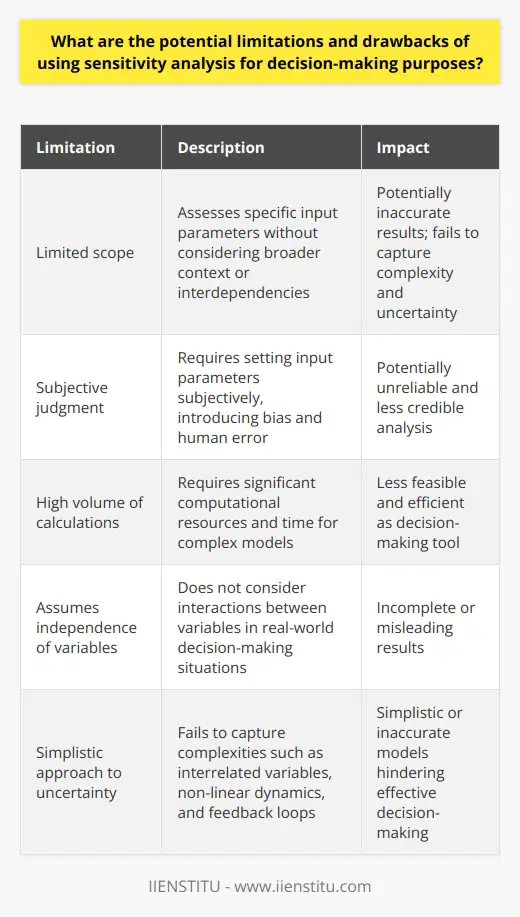
What are Modal Choice Decisions?
Exploring Modal Choice Decisions
Regarding travel planning and decision-making, one of the most critical aspects is the modal choice decision. It encompasses all the different types of transportation available. Therefore, understanding how people choose which mode to use while traveling is essential. This blog post will discuss the process of exploring modal choice decisions and the benefits of conducting a sensitivity analysis.
What Are Modal Choice Decisions?
Modal choice decisions are decisions related to selecting a particular type of transportation. These decisions usually involve weighing the time, convenience, cost, and safety associated with different modes of transportation to determine which one is best for the user. Therefore, it is essential to consider all these factors when making modal choice decisions to make the most rational and cost-effective decision for the user.
Exploring Modal Choice Decisions
It is essential to analyze the available options to make informed decisions about which mode of transportation is the most suitable for a given situation. This can include research into the routes, the costs and time associated with different modes of transportation, and the safety and comfort associated with them. This will give the user the best insights into the option most suits their situation.
Methods: To gain the most accurate understanding of modal choice decisions, it is essential to use an evidence-based approach to decision-making. Using qualitative data such as surveys and interviews can provide valuable insight into the motivations and intentions of users when making modal choice decisions. Additionally, quantitative techniques such as regression analysis can determine the correlation between modal choice decisions and various parameters such as cost and time.
Results: The results of this analysis can provide valuable insights into the motivations and intentions of people when making modal choice decisions. This can be used to create more informed and effective strategies for transportation planning. Additionally, the analysis can provide valuable insight into the cost and time associated with different modes of transportation. Finally, it can be used to improve existing transportation infrastructure.
Sensitivity Analysis
It is essential to conduct a sensitivity analysis to gain further insights into the effect of different variables on modal choice decisions. This technique determines how sensitive an individual or population is to changes in other variables. It can be used to gauge the impact of changes in variables such as cost and time on modal choice decisions. This can provide helpful information to transportation planners, allowing them to create more effective plans and strategies.
Models: To conduct a sensitivity analysis, it is essential to use appropriate models and software. These models can include various types, such as game-theoretic and experiential models. Different models may be more suitable depending on the nature of the analysis. These models can provide valuable insights into the impact of other variables on modal choice decisions.
Simulation: To better understand different populations' sensitivity to changes in other parameters, it is essential to use simulation. This is a process where changes in certain variables are simulated, and the effects on modal choice decisions are observed. This is a powerful tool that can provide valuable insight into the behaviors of different populations and provide information to transportation planners regarding the impact of parameter changes on modal choice decisions.
Modal choice decisions are an essential element of travel planning and decision-making. Therefore, it is crucial to understand how people make these decisions. By exploring modal choice decisions and conducting a sensitivity analysis, it is possible to gain valuable insight into the motivations and intentions of people and the effects of different variables. This can provide helpful information to transportation planners, allowing them to create more informed and effective plans and strategies for transportation infrastructure.
Our choices come with varying degrees of sensitivity; exploring our modal choice decisions is critical to making the right ones.
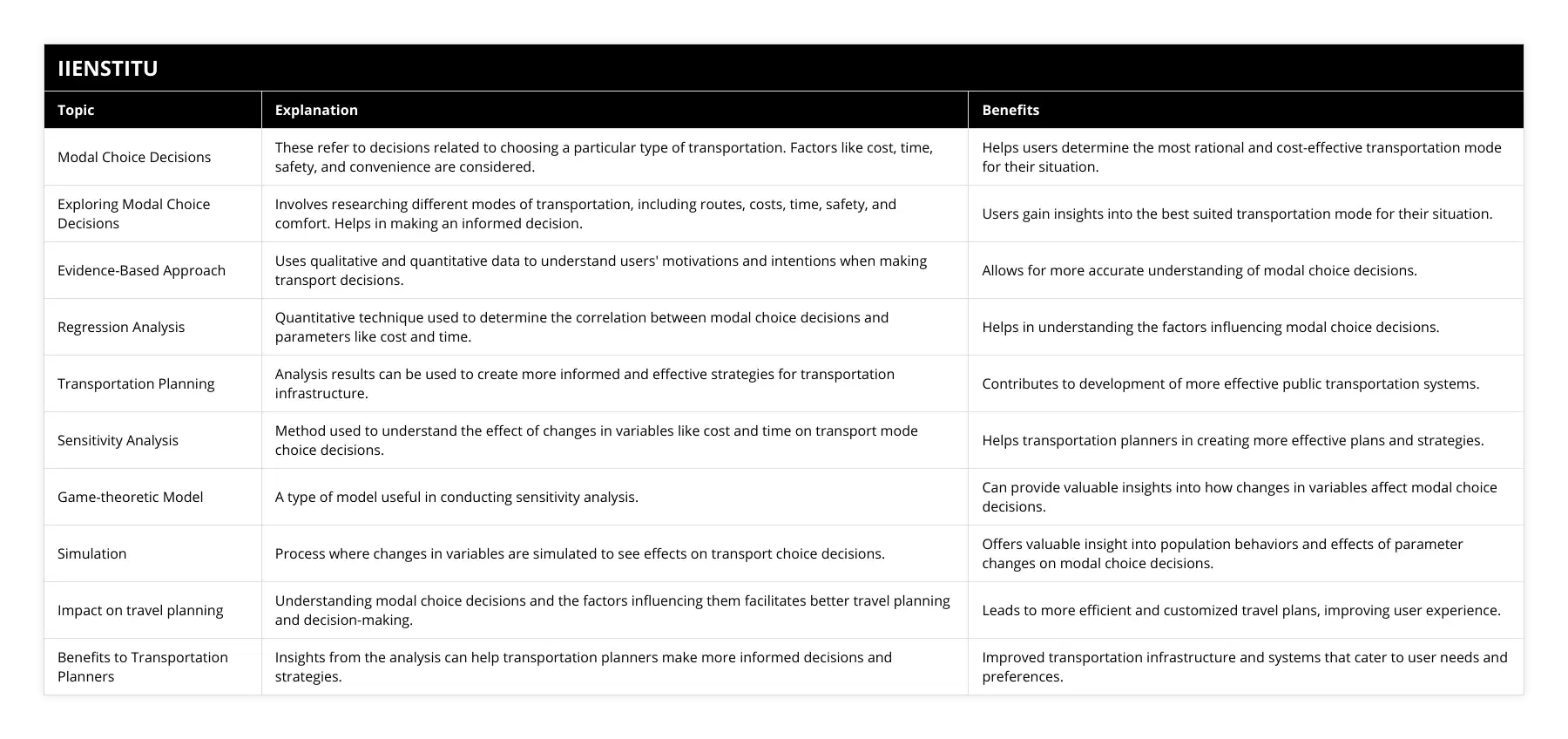
Frequently Asked Questions
What types of techniques are used to evaluate and measure the impacts of potential modal choice decisions?
Understanding how to evaluate and measure the impacts of potential modal choice decisions is essential for developing transportation systems that are efficient and cost-effective. Modal choice decisions involve selecting a particular type of public transportation, such as bus, subway, or walking, to fulfill a given transportation need. The techniques used to evaluate and measure the impacts of these decisions vary depending on the specific goals of the transportation system.
One technique is determining the cost-effectiveness of the modal choice decision by looking at the financial cost of construction, operation, and maintenance. The cost-effectiveness of any proposed modal choice can then be compared to other investment options. Another technique is to look at the environmental impacts of the decision. This involves analyzing the amount of greenhouse gas emissions, air pollution, and other environmental impacts associated with the chosen modal choice.
In addition, there are techniques for evaluating social impacts. This includes examining the degree to which the system would improve public safety and health and its potential to boost general welfare and equity. It also involves assessing the role of the modal choice in reducing traffic congestion, helping to support public health objectives related to physical activity, and connecting communities.
Finally, technology and data can be used to evaluate and measure the impacts of potential modal choice decisions. This includes analyzing travel patterns and transportation system usage and assessing how reliable the plan is for travelers. Additionally, remote sensing and predictive modeling tools can forecast the demand for various modal choices and predict their impacts.
Overall, various techniques are used to measure the impacts of potential modal choice decisions. Understanding the financial, environmental, social, and technological factors associated with these decisions is essential for developing efficient and cost-effective transportation systems.

What data is typically used to help develop sensitivity analyses?
Data from multiple sources are used to develop sensitivity analyses, which are integral to strategic decision-making. By analyzing data from various sources, it is possible to gain insights for planning and budgeting that consider different potential scenarios. The following types of data are typically used to develop sensitivity analyses.
Internal Data: The internal data of the organization, such as the financial, operations, sales, and marketing data of the company, should be carefully assessed to create a baseline. This data provides information on costs, income, sales, and customers that can be used to identify critical areas of risk and opportunity. In addition, this baseline can be used to assess the impact of potential changes in external conditions, such as the price of fuel or changes in the economy.
Market Data: To assess the potential impact of external conditions and competitors on the organization, market data should be collected. This data type can include macroeconomic indicators, industry data, sector trends, competitor analysis, customer trends, and other relevant market data. This data can identify critical areas of risk and opportunity in the market and help organizations anticipate environmental changes.
Financial Data: Financial data should be evaluated to assess the financial risks associated with the organization. This can include cash flow statements, balance sheets, and income statements to analyze the organization's financial position. In addition, these data points can be used to project and analyze different economic scenarios and assess the effect of potential changes in various areas, such as currency exchange rates or capital investments.
Strategic Data: Finally, data related to the organization's long-term goals and strategies should be evaluated. This includes data from internal and external sources related to the organization's strategic initiatives and longer-term plans. This data can be used to assess the potential risks and opportunities associated with the organization's strategies and to develop alternative methods in response to possible environmental changes.
In summary, the data used to develop sensitivity analyses can include a variety of internal and external data points. This data can be used to assess the potential impact of multiple scenarios on the organization and to develop alternative strategies in response to external changes.

How do sensitivity analyses account for different sources of variability when examining modal choice decisions?
Sensitivity analyses play a crucial role in elucidating the mechanism by which modal choices are made. Mobility, comfort, and cost are key factors influencing mode selection decisions. The variability within these different sources of influence dictates the dynamism of the selection process. To accurately capture the complexities of mobility behavior, examining modal choices with sensitivity analysis is required.
Sensitivity analysis involves testing the robustness of a system’s response to a range of changes within its parameters. Although sensitivity analysis is relatively common within the natural sciences, it has only recently gained traction in the social sciences. Regarding modal choice decisions, it is essential to account for different sources of variability in the decision-making process. Sensitivity analysis can explore other potential factors, and varying degrees of importance can be attributed to each element.
Examining modal choice decisions via sensitivity analysis can provide insight into significant ‘macro effects,’ such as environmental changes, socio-economic characteristics, and attitudes towards transport. Gaining a better understanding of macro effects can help provide a more comprehensive approach to public transport planning, including the effects of different sources of variability.
Several significant advantages exist regarding the specific benefits of using sensitivity analysis for analyzing modal choice decisions. It can be used to identify opportunities for cost efficiency, identify potential changes in traveler behavior, explore the impact of changes in fuel price on transport preferences, and identify the varying effects of changes in public transport policy on travelers. Additionally, sensitivity analysis can help identify potential infrastructure changes that improve travel flexibility and explore the likely impacts of personal mobility interventions on travelers.
Overall, sensitivity analysis provides a powerful tool for researchers and public transport planners to explore the intricacies of modal choice decisions. Sensitivity analysis can help identify changes likely to have meaningful effects on the environment, socio-economic factors, and traveler behavior, providing a better understanding of why confident modal choices are made. As such, it should be an integral part of any analysis of modal choice decisions.
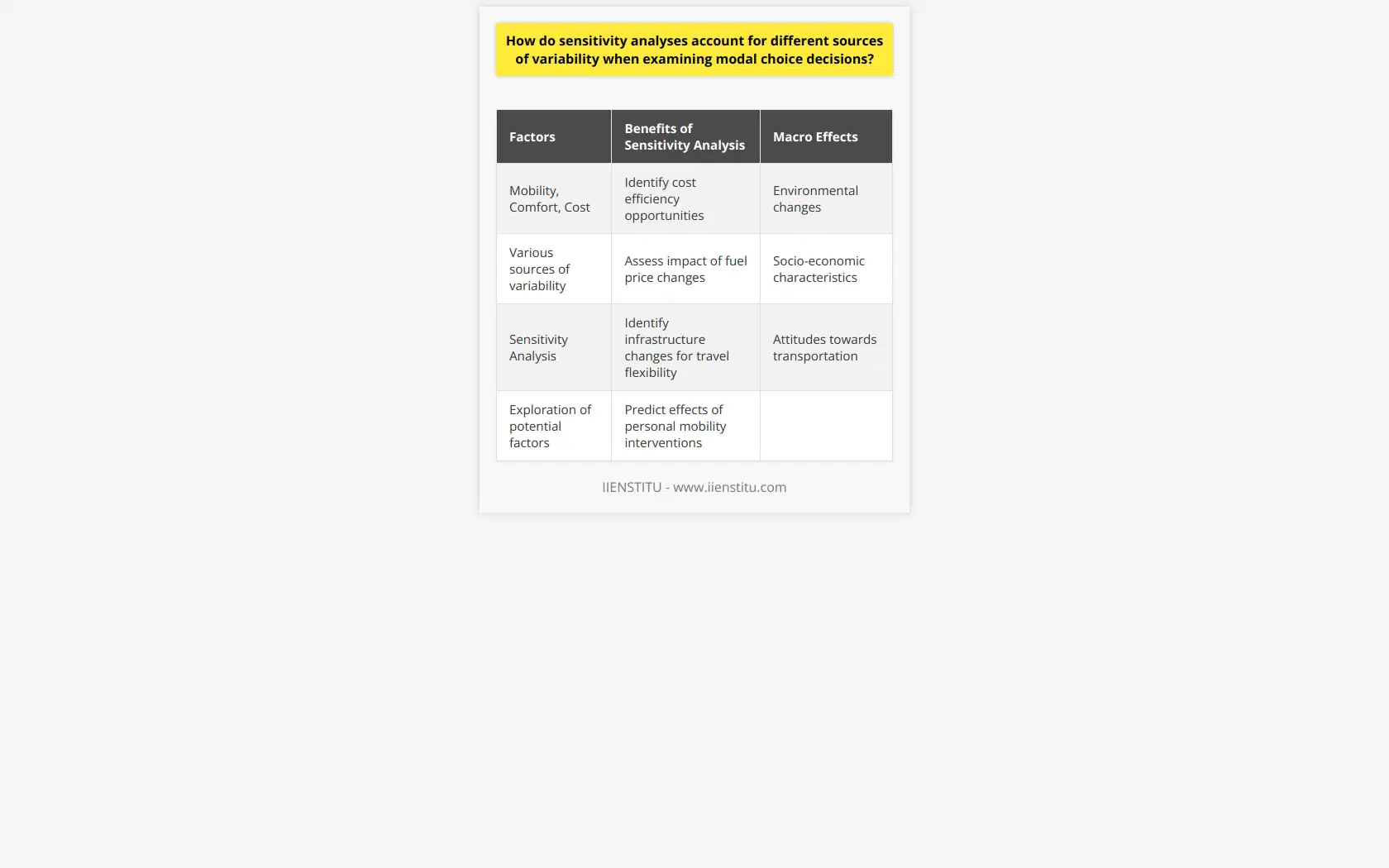
What is sensitivity analysis in decision analysis?
Understanding Sensitivity Analysis
Sensitivity analysis in decision analysis is a systematic approach employed to examine the impact of changing inputs in a decision-making process, thus revealing possible outcomes and their effects. It enables decision-makers to account for the inherent uncertainties associated with the inputs and to evaluate the robustness of their decisions.
Role of Sensitivity Analysis
In a decision-making process, decision-makers often make assumptions based on limited information and data. Sensitivity analysis allows them to assess the extent to which their choices remain favored when these assumptions are modified. By adjusting input parameters, this analysis generates various scenarios, providing an illustration of the possible range of outcomes.
Types of Sensitivity Analysis
There are three primary types of sensitivity analysis: one-way, two-way, and scenario. In a one-way analysis, the impact of a single variable is changed to observe the resulting impact on the decision model. Two-way analysis involves modifying two variables in tandem to evaluate their combined effect. Lastly, scenario analysis deals with the simultaneous alteration of multiple variables.
Benefits of Sensitivity Analysis
Sensitivity analysis offers numerous advantages in decision-making processes. First, it supports well-informed decision-making by illuminating the impacts of input uncertainty, assisting decision-makers in understanding the effects of their assumptions. Additionally, it highlights vital variables that most influence the model's output, helping prioritize further research and analysis. This analysis also supports risk management efforts by identifying potential weak points and potential high-impact events.
Limitations of Sensitivity Analysis
While sensitivity analysis proves invaluable to decision analysis, it is essential to recognize its limitations. First, it only reflects the sensitivity of the model to changes in inputs – not the actual probability of these input changes occurring. Furthermore, it assumes that all other factors remain constant, which may not hold true in real-world situations. Finally, it relies on the accuracy and validity of the decision model itself, making its effectiveness contingent on the model's underlying assumptions and structure.
In conclusion, sensitivity analysis is a crucial component of decision analysis, offering a systematic method to assess the impact of altering input parameters. By revealing possible outcomes and determining the key variables affecting decision-making, it enables decision-makers to evaluate the robustness of their assumptions and make better-informed choices. Although there are limitations, sensitivity analysis is a powerful tool when used in conjunction with other decision support techniques, ultimately helping decision-makers navigate uncertainty and mitigate potential risks.

What role does sensitivity analysis play in the development of a requisite decision model?
Understanding Sensitivity Analysis
Sensitivity analysis plays a crucial role in the development of a requisite decision model as it tests the robustness and reliability of the model. It assesses the impact of changes in input variables, parameters or assumptions on the output or outcome, which aids in achieving a more accurate and reliable model that aligns with the decision-making context.
Evaluating Model Robustness
One vital aspect of sensitivity analysis is the evaluation of the model's robustness, which refers to the stability of the model under varying conditions. By changing the values of input variables and parameters, sensitivity analysis helps identify those variables that have the most significant impact on the overall outcome. This information enables decision-makers to gain deeper insights into the model's strengths and weaknesses, ultimately leading to more informed choices.
Driving Model Refinement
An essential role of sensitivity analysis in developing a requisite decision model is to support the model refinement process. The findings from sensitivity analysis often reveal areas of the model that require enhancement or adjustments, especially when the model exhibits instability under certain conditions. Decision-makers can use this information to fine-tune the model's structure, parameters, and input variables, in turn ensuring that the model is adequately addressing the decision problem at hand.
Identifying Key Assumptions
Sensitivity analysis contributes to the identification of critical assumptions underlying the decision model. These are assumptions that, if altered, significantly impact the overall outcome or result. Recognizing such assumptions is necessary for decision-makers to develop an awareness of potential limitations and biases present in the model, helping them make more rational and informed decisions.
Facilitating Communicating Results
Lastly, sensitivity analysis can facilitate the communication of model results to various stakeholders. By illustrating the range of possible outcomes under different scenarios, sensitivity analysis helps stakeholders understand the level of uncertainty and risk involved in the decision-making process. Consequently, this promotes trust and confidence in the model and aids in decision-making.
In conclusion, sensitivity analysis is indispensable for the development of a requisite decision model. It ensures robustness, drives model refinement, identifies key assumptions, and facilitates the communication of results to stakeholders. Incorporating sensitivity analysis into the model development process is essential to create an accurate, reliable and transparent decision model that serves the needs of decision-makers.

What is sensitivity analysis of a model?
Understanding Sensitivity Analysis
Sensitivity analysis is a vital technique that allows researchers and decision-makers to examine how a model's output varies with changes in its input parameters. Essentially, it measures the robustness of a model by assessing how sensitive the results are to changes in the underlying data or assumptions.
Identifying Key Inputs
The first step in conducting a sensitivity analysis is to identify the key input parameters in the model. These parameters represent the independent variables or factors that can influence the output of the model. Examples of input parameters include interest rates, costs, prices, and probabilities.
Varying Parameter Values
Next, the input parameters are changed individually or in combination to evaluate their impact on the model's output. This can be done by altering the values within their reasonable range or using scenario-based approaches, such as worst-case, best-case, or base-case scenarios. Additionally, sensitivity analysis can involve probabilistic methods, where the input parameters are assigned probability distributions to simulate different potential outcomes.
Analyzing Results
Once the input parameters have been varied, the model's output is analyzed to determine the level of sensitivity of the results. This helps establish which input parameters have the greatest influence on the model output, enabling researchers and decision-makers to prioritize their focus on these critical factors. Some common sensitivity measures include elasticity, partial rank correlation, and regression coefficients.
Benefits and Limitations
Sensitivity analysis offers several benefits, such as improving model transparency, identifying data gaps, and aiding in the validation process. However, it also has some limitations, including difficulties in quantifying all uncertainties, dealing with correlated input parameters, and ensuring accurate representation of complex relationships.
In conclusion, sensitivity analysis plays a crucial role in understanding the impact of changes in input parameters on a model's output. It provides valuable insights into the robustness of the model and aids in decision-making processes, making it an essential tool for researchers and practitioners.

What are the key components and assumptions involved in sensitivity analysis for decision making?
Key Components of Sensitivity Analysis
Sensitivity analysis is a crucial approach to assess the impact of uncertainty in decision-making processes. It requires an evaluation of model components, as elaborated below.
Input Parameters and Assumptions
The first crucial component is the identification and assessment of input parameters and assumptions. These elements can be quantitative, such as cost estimates, or qualitative, such as potential risks. They are invaluable in determining the range of possible outcomes under various scenarios.
Model Structure
The structure of the decision-making model is another key aspect of sensitivity analysis. The relationships between inputs and outputs, as well as the assumptions made in these relationships, establish the basis for assessing how changes in the components influence the results.
Output Metrics
Establishing specific output metrics, measurable characteristics that indicate the effectiveness of a decision, is vital to sensitivity analysis. These metrics may include financial measures, such as return on investment or project costs, or non-financial aspects like customer satisfaction and environmental impact.
Uncertainty Quantification
Quantifying uncertainties and assigning probabilities to different outcomes are essential aspects of sensitivity analysis. This process involves characterizing variations in input parameters, assumptions, or model structure to gauge the level of confidence in the results.
Scenario Analysis
An integral part of sensitivity analysis is the development and evaluation of alternative scenarios. This approach allows decision-makers to explore the consequences of possible changes and assess the resilience of their decisions under different future conditions.
Outcome Ranking
Outcome ranking involves prioritizing the results of different scenarios based on the preferred criteria for decision-makers, such as minimizing costs, maximizing benefits, or satisfying specific performance targets. This process helps in making informed choices.
In conclusion, sensitivity analysis aids decision-makers in understanding the uncertainty associated with their choices by examining the key components and assumptions involved. By evaluating input parameters, model structure, output metrics, uncertainty quantification, scenario analysis, and outcome ranking, it allows for a thorough assessment of the potential impacts and risks of various decisions.
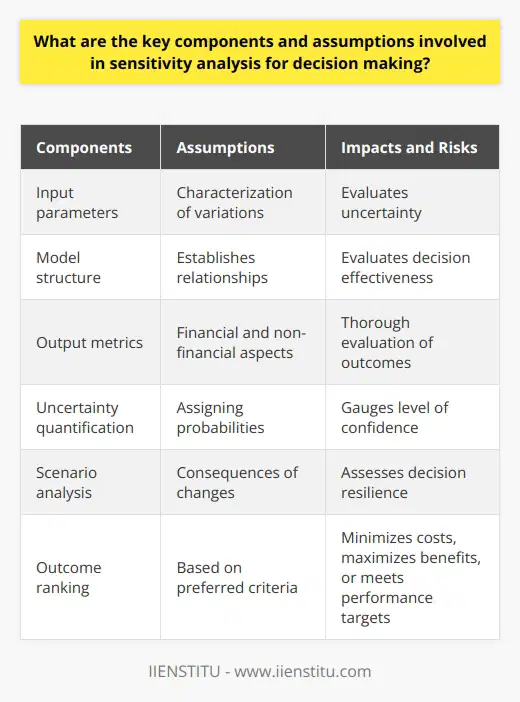
How do sensitivity analysis results influence the overall decision-making process, and what are the potential outcomes?
Influence on Decision-Making Process
Sensitivity analysis results play a crucial role in the decision-making process by revealing the robustness of decisions under varying assumptions. It enables the decision-makers to assess the impact of uncertainty and potential risks associated with different scenarios. By evaluating how sensitive the preferred choice is to changes in data or assumptions, decision-makers can gain insights into the stability and reliability of their choices.
Identifying Key Variables and Prioritizing Resources
Furthermore, sensitivity analysis highlights key variables which significantly alter the outcomes of decisions. This identification enables decision-makers to prioritize resources effectively and focus on essential aspects that could lead to better outcomes. By addressing the potential inputs with high uncertainty or variability, the decision-making process can be fine-tuned, ultimately resulting in more informed choices.
Confidence in Decision Implementation
Another important aspect of sensitivity analysis is the increased confidence it gives decision-makers when implementing the chosen approach. By understanding the potential effects of uncertainties, they can better justify their decisions and mitigate adverse results. This insight is particularly valuable for communicating the reasoning behind the decision to stakeholders and for designing contingency plans.
Balancing Trade-offs and Developing Strategies
Sensitivity analysis results also assist in balancing trade-offs between different options, fostering a more comprehensive approach in decision-making. By comparing multiple scenarios, decision-makers can develop strategies that cater to diverse needs and preferences, maximizing overall benefit or minimizing potential costs. This holistic approach leads to more flexible and adaptable decision-making processes.
Conclusion
In conclusion, sensitivity analysis results significantly influence the decision-making process by providing valuable insights into stability, reliability, and the robustness of different choices. They assist in identifying key variables, prioritizing resources, instilling confidence in decision implementation, and balancing trade-offs. Ultimately, sensitivity analysis aids in enhancing the effectiveness and adaptability of the overall decision-making process, leading to improved outcomes.
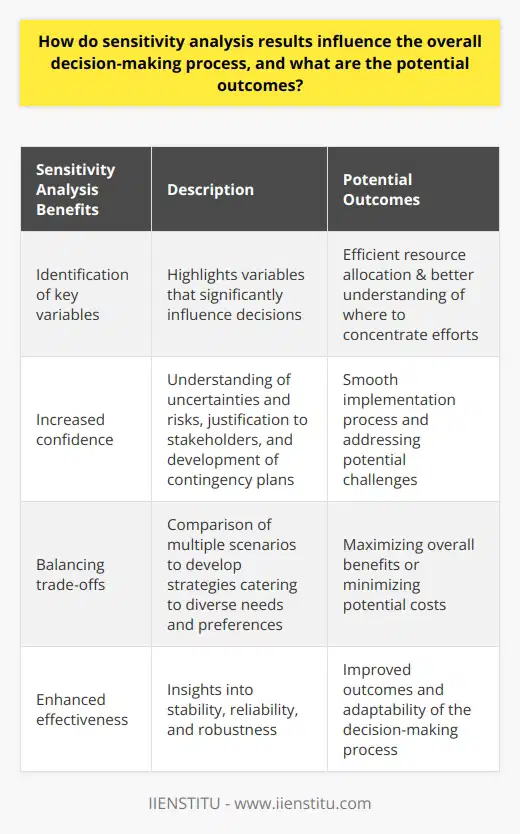
In what contexts is sensitivity analysis particularly helpful or relevant for effectively informing decision-making?
Contexts for Sensitivity Analysis
Financial Planning and Investment
Sensitivity analysis serves as an essential tool for informing decision-making in financial planning and investment contexts. It allows decision-makers to assess the potential impact of changes in variables, such as interest rates, currency, and inflation, on the overall financial outcome. By understanding how these variables may affect the model's output, they can enhance the robustness of their decisions and better allocate resources.
Project Management and Cost Estimation
In project management, sensitivity analysis plays a crucial role, especially in cost estimation and resource allocation. Decision-makers can identify critical factors that may cause significant fluctuations in a project's cost and performance metrics by examining changes in various input parameters such as labor, materials, and project duration. Thus, managers become better equipped to make informed decisions and mitigate potential risks.
Environmental and Climate Change Policies
Sensitivity analysis is particularly beneficial when examining the potential impacts of environmental and climate change policies. For instance, it allows policy-makers to estimate how different emission reduction scenarios affect temperature rise, sea levels, and other environmental aspects. By comprehending the implications of various policies, decision-makers can ensure more informed decisions and ensure adaptive measures fit the needs of each specific context.
Healthcare and Epidemiological Studies
In healthcare and epidemiological studies, sensitivity analysis is critical for understanding the interplay of several factors influencing patients' outcomes or disease spread. By exploring the influence of variable factors such as treatment effectiveness, prevalence, and risk factors, decision-makers can tailor medical interventions and prevention strategies accordingly. It also aids in anticipating potential challenges, contributing to the overall effectiveness and resilience of healthcare systems.
Supply Chain Management
Sensitivity analysis is invaluable in supply chain management, as it helps in evaluating the possible impacts of changes in demand, production capacity, or lead times on inventory levels and costs. By understanding the vulnerabilities and uncertainties within a supply chain, managers can make informed decisions on sourcing strategies, inventory management, and risk mitigation, enhancing overall supply chain resilience and efficiency.
In summary, sensitivity analysis is a vital tool that can significantly inform decision-making in various domains such as financial planning, project management, environmental policy, healthcare, and supply chain management. By analyzing the potential impacts of changes in key variables within models, decision-makers can improve their decisions' robustness and ultimately achieve better outcomes.
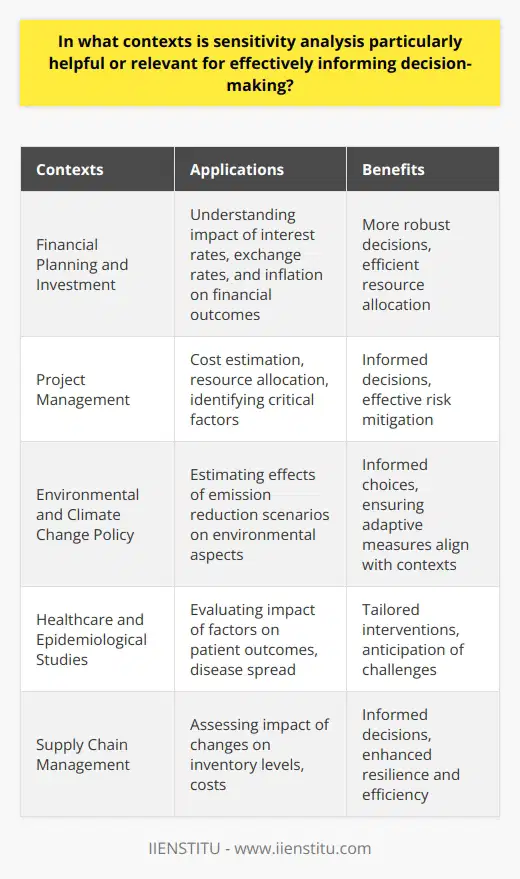
What is the role of a sensitivity analysis in determining the robustness of a decision-making model?
Role of Sensitivity Analysis in Decision-Making Models
Assessing Variable Impact
A sensitivity analysis plays a crucial role in determining the robustness of a decision-making model by systematically assessing the impact of changes in input variables on the outcomes generated by the model. Employing sensitivity analysis helps decision-makers identify the extent to which their final choice will be affected by alterations in the values of various factors.
Identifying Key Drivers
Through sensitivity analysis, decision-makers can recognize the key drivers responsible for the most significant changes in the model outputs. By understanding the dominant elements, decision-makers can focus on the critical factors that determine the model's success, allowing them to allocate necessary resources and prioritize actions to better manage uncertainties and risks in the decision-making process.
Uncertainty Quantification
Incorporating sensitivity analysis in decision-making models offers the advantage of quantifying uncertainties inherent in the input variables. It aids decision-makers in comprehending the overall degree of uncertainty associated with their decision, helping them to acknowledge the necessity for incorporating flexibility in their actions and strategies to accommodate the unpredictable nature of real-world decision-making situations.
Supporting Model Validation
The use of sensitivity analysis in decision-making models contributes to the model validation process. By comparing the sensitivity of the model to the expected behavior of real-world phenomena or the system being studied, decision-makers can check the model's credibility and its alignment with empirical data. Any deviations from the expected results can lead to further investigation and refinement of the model, thereby enhancing its reliability and robustness.
Improving Confidence in Decision-Making
Ultimately, the employment of sensitivity analysis in decision-making models fosters a higher level of confidence in the choices made, as it provides a more informed understanding of the underlying causal relationships among input variables and the model outcomes. With the insights gained from sensitivity analysis, decision-makers can devise more resilient and adaptable strategies, which are better equipped to perform under varying conditions, thereby enhancing the overall robustness of the decision-making model.

How can sensitivity analysis aid in identifying critical parameters or uncertainties within a decision-making process?
Role of Sensitivity Analysis in Decision-Making
Sensitivity analysis plays a crucial role in identifying critical parameters and uncertainties within a decision-making process. It is a systematic approach used to study the impact of variations in input values on the output or decision outcome. By assessing the impact of changes on key factors or assumptions, sensitivity analysis guides decision-makers to evaluate scenarios and select the most appropriate one.
Identifying Critical Parameters
A primary goal of sensitivity analysis is to help discover which parameters have the greatest influence on results. By varying the values of these parameters and observing the changes in the output, we can gain insights into the relationships between input variables and the final outcome. Consequently, decision-makers can prioritize those parameters that significantly affect the results and focus on obtaining accurate data or making informed estimates for these critical variables.
Uncertainty Quantification
In a decision-making process, there are usually multiple uncertain variables that need to be considered. Sensitivity analysis enables the quantification of the relative contribution of each uncertainty to the overall variation in the output. This helps in understanding the effect of uncertainties on the decision outcome and guides the decision-maker towards more robust choices. Furthermore, sensitivity analysis suggests areas where additional information could potentially reduce the level of uncertainty, thus enhancing the quality of decision-making.
Risk Assessment and Mitigation
Sensitivity analysis is also valuable in assessing and mitigating potential risks in a decision-making process. By identifying the parameters with the highest impact on the outcome, decision-makers gain an understanding of which variables have the potential to create significant risks. Additionally, it provides insights into the relationships between variables and the trade-offs that may arise when adjusting values. Thus, sensitivity analysis is a practical tool for exploring potential consequences of various decisions and selecting strategies that minimize risks while maximizing benefits.
Enhancing Decision-Making Confidence
Incorporating sensitivity analysis in decision-making processes ultimately boosts the confidence of decision-makers by highlighting the crucial factors and uncertainties affecting the chosen course of action. Through the knowledge gained, decision-makers become better equipped to analyze and justify their choices, addressing potential criticisms or concerns regarding the decision. This ultimately results in more educated and well-informed decisions, improving the overall efficiency and effectiveness of the decision-making process.
In conclusion, sensitivity analysis aids decision-makers in identifying critical parameters, quantifying uncertainties, assessing and mitigating risks, and enhancing the overall confidence in their choices. By utilizing this analytical tool, decision-makers can make more effective, informed decisions that optimize outcomes and reduce potential risks.
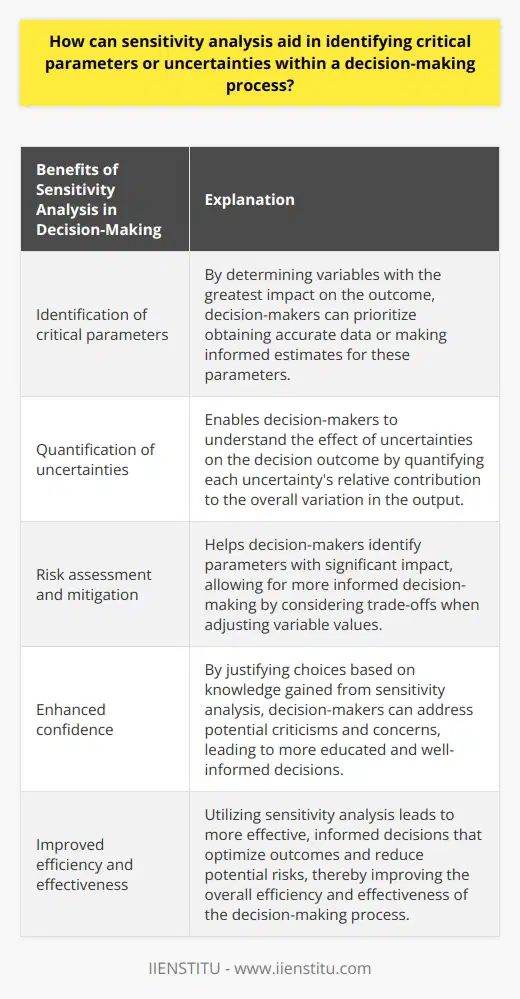
In what ways can sensitivity analysis be used to validate or improve predictive models in various fields of study, such as economics, engineering, or environmental management?
**Sensitivity Analysis in Predictive Models**
Sensitivity analysis serves as a valuable tool in validating and enhancing predictive models in diverse fields such as economics, engineering, and environmental management. By systematically varying the inputs of a model and observing the corresponding changes in its outputs, researchers can assess the robustness of their predictions and identify crucial factors driving the outcomes.
**Assessing Model Robustness**
A key application of sensitivity analysis in predictive modeling is gauging the stability of the model's conclusions. By exploring the impact of different input values on the model's output, researchers can discern whether the model maintains consistent results under varied conditions. In the context of economics, for example, a sensitivity analysis could evaluate the impact of assumptions about interest rates or inflation on an economic growth forecast. Such assessments help identify the range of uncertainty and cautiously interpret the findings.
**Uncovering Crucial Drivers**
Another way sensitivity analysis improves predictive models is by revealing the critical input factors influencing the model's results. By comparing the relative impact of different inputs on the output, researchers can pinpoint the most consequential drivers and focus their efforts on collecting accurate data on these key parameters. In engineering, for instance, sensitivity analysis can demonstrate which variables, such as material properties or load conditions, are most influential in the behavior of a structural system. This understanding enables engineers to make informed decisions about design improvements and safety measures.
**Identifying Interactions between Factors**
Sensitivity analysis also helps uncover complex interactions between input variables that affect the model's outcome. These insights can improve model accuracy and provide a deeper understanding of the underlying mechanisms at play. In environmental management, for instance, sensitivity analysis can show how factors like species interactions, habitat quality, and climate change impact ecosystem dynamics. Recognizing these compound interactions can guide resource managers towards integrated conservation strategies that encompass multiple drivers of change.
**Informing Model Improvements**
Lastly, sensitivity analysis can inform further refinements to a predictive model, ultimately enhancing its reliability and overall performance. By identifying areas where the model is most sensitive, researchers can concentrate on refining equations, parameter estimation techniques or better representation of processes. For example, in water resource management models, sensitivity analysis might reveal that the representation of specific hydrological processes is inadequate, prompting researchers to improve the algorithms or data inputs.
In summary, sensitivity analysis offers indispensable assistance in validating and enhancing predictive models across various domains. By probing the impact of input variations, the robustness of a model's conclusions, critical drivers, and complex interactions between factors can be revealed, leading to substantial improvements in model accuracy and understanding of the underlying system dynamics.

What are the key objectives and benefits of incorporating sensitivity analysis in decision-making models?
**Sensitivity Analysis in Decision-Making Models**
The primary objective of incorporating sensitivity analysis into decision-making models is to assess the robustness and stability of a specific model under various conditions. By systematically modifying the input parameters within the model, sensitivity analysis can help identify which inputs exert the greatest influence on the model's outcome. This information is essential in understanding the degree of uncertainty within the model, providing insights into potential areas for improvement or further research.
**Key Benefits of Sensitivity Analysis**
One of the main benefits of sensitivity analysis is better decision-making, as it enables organizations to weigh potential risks and manage uncertainties associated with their decisions. By identifying the main drivers of change in model outputs, sensitivity analysis can inform strategies to mitigate these risks, leading to more effective decision-making processes.
Another advantage of sensitivity analysis is its ability to improve the model's calibration and generalizability. By evaluating the influence of various input parameters on the model's outcome, sensitivity analysis can help guide the refinement and calibration of these parameters, ensuring they accurately reflect the underlying system being modeled. This process may also reveal structural issues within the model, enabling researchers to address limitations and improve the model's generalizability to different contexts.
**Enhancing Communication and Collaboration**
Incorporating sensitivity analysis into decision-making models can also facilitate communication between stakeholders and foster more effective collaboration. By providing a systematic approach to understanding and interpreting the model's outputs, sensitivity analysis can serve as a shared language amongst diverse stakeholders, allowing for informed discussions and enhanced comprehension of key uncertainties within the decision-making process. This increased understanding can lead to better collaboration, where various parties can work together to determine the best course of action.
**Optimizing Resource Allocation**
Finally, sensitivity analysis plays a critical role in optimizing resource allocation by informing decisions on which inputs to prioritize. Identifying the most impactful parameters allows organizations to make informed choices about where to invest their resources, ensuring the most significant returns on investment. This strategic allocation of resources can optimize the decision-making process and improve overall business performance.
In conclusion, incorporating sensitivity analysis into decision-making models offers multiple benefits, including assessing the model's stability, enhancing decision-making, improving model calibration, fostering communication and collaboration, and optimizing resource allocation. These advantages ultimately lead to more effective decision-making processes and better business outcomes.

How does sensitivity analysis contribute to the assessment of risk and uncertainty in various sectors, including finance, healthcare, and infrastructure planning?
Sensitivity Analysis in Risk and Uncertainty Assessment
Understanding Sensitivity Analysis
Sensitivity analysis contributes to the assessment of risk and uncertainty in various sectors by systematically examining the impact of varying input parameters on the outcomes of a decision-making process. This methodology allows decision-makers to identify critical factors affecting the results and determine the robustness of a particular solution under different conditions.
Application in Finance
In the finance sector, sensitivity analysis plays a vital role in assessing investment risks and portfolio performance. By stressing financial models with different input assumptions, analysts can predict how a change in interest rates, market volatility, or economic conditions may affect asset prices and cash flows. Furthermore, sensitivity analysis aids in optimizing portfolio allocations by identifying combinations of assets that minimize risk while maximizing expected returns.
Role in Healthcare
In healthcare, sensitivity analysis helps identify treatment strategies that balance effectiveness and cost, while mitigating adverse outcomes and resource constraints. By testing the robustness of health economic models under various scenarios, decision-makers can evaluate the safety and efficacy of new interventions, determine patient subgroups that may benefit most, and better allocate resources for maximum health impact. Additionally, sensitivity analysis can inform policy decisions regarding the adoption of novel technologies, reimbursement schemes, and public health interventions.
Influence on Infrastructure Planning
Sensitivity analysis is crucial in infrastructure planning to assess the feasibility and long-term stability of projects under different future scenarios. By altering key variables such as demand, costs, and external factors, planners can evaluate the resiliency of proposed solutions and identify potential vulnerabilities in system performance. Sensitivity analysis also allows decision-makers to prioritize investments by comparing risk-adjusted returns for various projects and exploring the interdependencies between infrastructure systems.
Conclusion
In summary, sensitivity analysis serves as a powerful tool for effectively assessing and managing risks and uncertainties in various sectors, including finance, healthcare, and infrastructure planning. By exploring the effects of changes in key parameters, decision-makers can identify critical areas of concern, evaluate solution robustness, and allocate resources more efficiently to optimize outcomes under uncertain conditions.
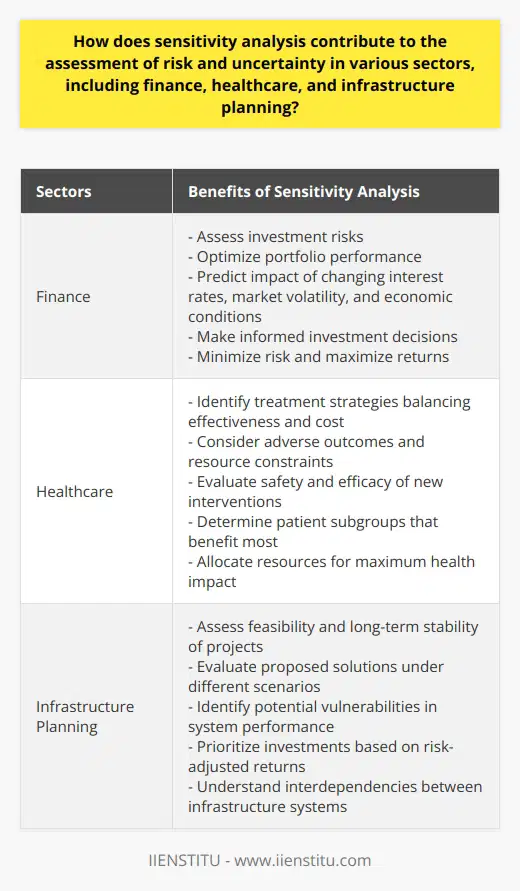
When should stakeholders consider implementing a sensitivity analysis during the decision-making process, and what factors might determine its level of importance?
Subheading: Appropriate Timing for Sensitivity Analysis
Stakeholders should consider implementing a sensitivity analysis during the decision-making process when there are uncertainties in the input variables. This analysis allows decision-makers to assess the potential impact of these uncertainties on the expected outcome. Implementing the analysis early in the process enables stakeholders to identify key variables that require additional focus, ensuring well-informed decisions.
Subheading: Factors Influencing Importance of Sensitivity Analysis
The level of importance of sensitivity analysis depends on various factors. First, the complexity of the decision-making problem is a significant factor. In complex situations involving multiple variables and uncertainties, sensitivity analysis becomes more vital to understand the relationships between variables and their potential impacts. Second, the magnitude of uncertainties related to input variables affects the importance of the analysis. Higher levels of uncertainty increase the need for sensitivity analysis to evaluate possible outcomes based on different scenarios.
Subheading: Role of Decision-Maker Expertise
Another factor determining the importance of sensitivity analysis is the expertise and experience of the decision-maker. Experienced decision-makers might have a better understanding of the potential impacts of uncertainties and may not need extensive sensitivity analysis to make informed decisions. However, less experienced decision-makers or those who lack familiarity with specific situations would likely benefit from conducting a thorough sensitivity analysis.
Subheading: The Value of Stakeholder Input
The involvement of diverse stakeholders in the decision-making process is crucial for understanding different perspectives, needs, and expectations. Sensitivity analysis can facilitate the inclusion of stakeholder input in the decision-making process, ensuring that various concerns are addressed adequately. Therefore, the level of importance of sensitivity analysis would likely increase in situations where a high degree of stakeholder involvement is necessary or desired.
Subheading: Presence of Resource Constraints
Resource constraints, such as time, data availability, and financial resources, might also affect the level of importance of sensitivity analysis. In cases where resource constraints are severe, decision-makers may need to prioritize the most critical variables for analysis. In such situations, the importance of sensitivity analysis might be limited but still essential to help with decision-making.
In conclusion, stakeholders should consider implementing a sensitivity analysis during the decision-making process when faced with uncertainties in input variables. The importance of this analysis can be determined by factors such as complexity, uncertainties, decision-maker expertise, stakeholder input, and resource constraints.

What is the purpose and significance of sensitivity analysis in decision-making processes?
Purpose of Sensitivity Analysis
The primary purpose of sensitivity analysis in decision-making processes is to quantify the effect of varying input variables on the predicted outcome. It serves as a crucial tool for assessing the robustness of the predictions and models used in decision-making processes. Sensitivity analysis can help decision-makers identify the most influential factors in a system, understand the likely consequences of changes in these factors, and prioritize action to improve management strategies.
Significance in Decision-Making Processes
In decision-making processes, sensitivity analysis aids in determining the inherent uncertainty in projecting outcomes. This analysis considers a wide range of possible scenarios and provides an understanding of the impact of different assumptions and parameter values on the decision outcome. Ultimately, this enables decision-makers to evaluate the risks and trade-offs associated with their choices, leading to better-informed decisions.
Enhancing Model Credibility
One significant benefit of sensitivity analysis is that it improves the credibility of the models used in decision-making processes. By systematically exploring how variations in input parameters affect the outcomes, decision-makers can validate the model's behavior across a broad range of scenarios. This builds confidence in the model's ability to provide reliable and accurate projections for decision-making.
Risk Management and Uncertainty Reduction
Sensitivity analysis plays a pivotal role in risk management and uncertainty reduction. By identifying the input variables that significantly affect the output, decision-makers can determine the risk associated with their decisions based on the range of possible outcomes. This allows them to develop contingency plans and make well-informed choices, even in the face of uncertainty.
Improving Decision-Making Efficiency
Finally, sensitivity analysis improves the efficiency of decision-making processes by guiding which variables need attention and further investigations. This type of targeted analysis streamlines the process by focusing resources, data collection, and research efforts on the most relevant factors. As a result, decision-makers can make more informed decisions in a timely manner and allocate resources more effectively.
In conclusion, sensitivity analysis plays an essential role in the decision-making process by quantifying the impact of varying input variables on outcomes, enhancing the credibility of models, supporting risk management, reducing uncertainty, and improving efficiency. By incorporating sensitivity analysis into decision-making processes, decision-makers can make well-informed choices that mitigate risks and uncertainties while maximizing the effectiveness of their actions and resource allocations.

How does sensitivity analysis help in addressing the challenges of uncertainty and measurement errors in decision-making models?
**Role of Sensitivity Analysis in Decision-Making Models**
Sensitivity analysis plays a critical role in addressing the challenges of uncertainty and measurement errors in decision-making models. By examining the impact of variations in input parameters, sensitivity analysis helps identify the parameters that have the most significant effect on model outcomes.
**Addressing Uncertainty in Model Inputs**
Uncertainty in decision-making models can arise from various sources, such as data limitations, assumptions, and external factors. Sensitivity analysis allows modelers to assess the impact of uncertainty by testing different scenarios and understanding how variations in inputs affect the model. This process highlights areas where data quality and input assumptions need to be improved, which helps enhance the overall accuracy and reliability of the model.
**Mitigating Measurement Errors in Model Outputs**
Measurement errors can significantly affect the validity of model outputs and lead to incorrect decision-making. Sensitivity analysis assists in identifying the input parameters that contribute most to measurement errors, allowing modelers to focus on improving these specific aspects. By mitigating measurement errors, sensitivity analysis enhances the reliability of model outputs and ensures that decision-makers have access to accurate information.
**Evaluating Model Robustness**
Sensitivity analysis also plays a vital role in evaluating the robustness of decision-making models. It helps determine how sensitive the model's outputs are to changes in input parameters. This information allows modelers to understand the degree to which the model can tolerate perturbations, which is essential when considering the stability and reliability of the model.
**Improving Model Calibration**
Another advantage of sensitivity analysis is its ability to aid in model calibration. By identifying the most influential parameters, sensitivity analysis helps modelers focus their efforts on calibrating the model to the most relevant input data accurately. As a result, this increases the overall effectiveness of the model and supports better decision-making.
**Informed Decision-Making**
In conclusion, sensitivity analysis contributes significantly to addressing the challenges of uncertainty and measurement errors in decision-making models. By determining the most influential parameters, improving data quality and model calibration, and ensuring robustness, sensitivity analysis enables decision makers to make well-informed choices based on accurate and dependable model outcomes.
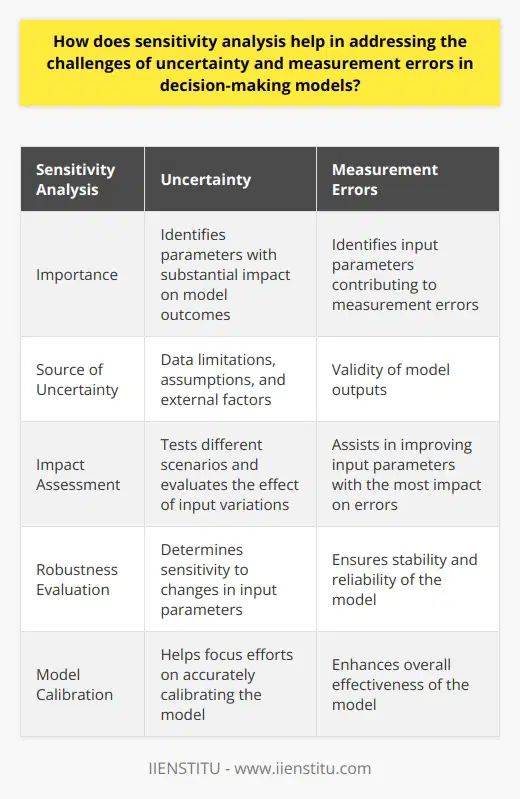
What are the potential limitations and drawbacks of using sensitivity analysis for decision-making purposes?
Limitations of Sensitivity Analysis
Limited Scope of Sensitivity Analysis
One primary limitation of sensitivity analysis is its limited scope. Sensitivity analysis focuses on assessing the impact of varying specific input parameters without considering the broader context or the interdependencies between various factors. As a result, it may fail to accurately capture the complexity and uncertainty in decision-making situations, undermining the usefulness of its results for decision-makers.
Subjective Judgment in Setting Parameters
Another drawback of sensitivity analysis is the need for subjective judgment in setting certain input parameters, such as probabilities or ranges for variables. Since these decisions rely on the analysts' expertise and experience, bias and human error can potentially skew the results. This subjectivity may diminish the credibility of the analysis and hinder effective decision-making.
Computational Challenges
Sensitivity analysis often requires a high volume of calculations to evaluate multiple scenarios. This reliance on computation can pose challenges, especially when the model is complex and involves numerous interrelated variables. In such cases, computational resources and time required may be significant, making the analysis less feasible and efficient.
Ignoring Interactions between Variables
Sensitivity analysis typically assumes that the variables under consideration are independent, which is often not the case in real-world decision-making situations. Consequently, sensitivity analysis may not consider the interaction effects between variables, leading to incomplete or potentially misleading results. This inherent issue with sensitivity analysis can limit the relevance and applicability of its insights for decision-making purposes.
Simplistic Approach to Uncertainty
A critical drawback of sensitivity analysis is its assumption that uncertainty can be represented by simple perturbations of input parameters. In reality, the nature and sources of uncertainty are often more complex, involving interrelated variables, non-linear dynamics, and feedback loops. Sensitivity analysis fails to capture such complexities in its assessment, potentially generating simplistic or inaccurate models that undermine effective decision-making.
In conclusion, the potential limitations and drawbacks of using sensitivity analysis for decision-making purposes include its limited scope, subjective judgment in setting parameters, computational challenges, ignoring interactions between variables, and its simplistic approach to uncertainty. Despite its merits as a convenient tool for exploring the impact of varying parameters, decision-makers should acknowledge its limitations and rely on other methods or techniques that better address the complexities inherent in real-world decision-making situations.
